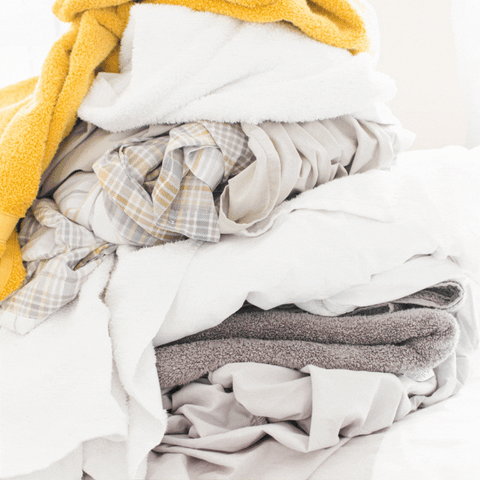
Cloth napkins every day? Really?
Looking for ways to reduce waste and make sustainable choices in your daily life? While switching from disposable products to reusable alternatives is an obvious move in the right direction, it can be daunting to forgo the convenience of some single-use household items. With all we have going on, sometimes convenience is everything.
This is the thinking I encounter when I talk to folks about my hand-dyed cloth napkins. But I see this as a false dichotomy. You don't always have to choose between convenience and eco-friendliness.
There are some prevalent misconceptions about cloth napkins, including the notion that they are fussy or formal, the belief they create excessive laundry and the impression that they are difficult to care for. In this blog post, I will debunk these myths and describe how my family uses them on a daily basis.

- Myth: Cloth napkins are fussy and formal.
Truly, my family does use cloth napkins for every meal (and snack), every day. And I love that little luxury. Once you get used to cloth, you will never go back to scratchy paper napkins. Trust me.

- Myth: Cloth napkins generate excessive laundry.
My family of two usually goes through 4-8 napkins in a given week (depending on how many times we have tacos for dinner), maybe 12 if we have company. I can fit 50 napkins in a single load in my average top-load HE washing machine.

- Myth: Cloth napkins are difficult to care for.
If you don’t get around to folding them right away, they do need to be smoothed flat (just with your hand) before folding. Sometimes the hemmed edges gets turned.

How my family uses cloth napkins every day…
-
I keep 2 small baskets in my dining room cabinet, one for clean napkins and one for dirty.

-
I use napkins that are coordinating, but different. My set of choice right now are the Everyday Cotton Napkins in Indigo Shibori. Each napkin in the set of 4 is a different pattern. I use the circle and stripe patterns and my husband uses the spider web and scrunch patterns. That way we always know whose napkin is whose. Another option is the Rainbow set of 6- great for larger families. Before I started dyeing napkins, we had two sets of store-bought napkins in different coordinating colors. I always used tan, while my husband used brown.
-
Whatever napkins are currently in use live on the dining room table or counter. When either one starts to look dirty, they both get tossed in the “dirty” basket and a pair of fresh napkins comes out of the “clean” basket.
-
On laundry day, we grab all the dirty ones and toss them in the wash with the towels and socks.
-
For my family of two, 8 napkins is plenty for daily use. 12 is enough to cover when we have company.
Advantages of cloth napkins…
I think the benefits are pretty obvious, but here’s a quick rundown…- Environmental impact: By choosing cloth napkins, you can significantly reduce your contribution to landfill waste. According to the Paperless Project, it takes approximately 51,000 trees and 60 million gallons of water to produce one day's worth of paper napkins for the U.S. alone. Cloth napkins, on the other hand, are reusable and can last for years, significantly minimizing the environmental footprint.
- Cost-effectiveness: Though cloth napkins require an initial investment, they can save you money in the long run. Disposable paper napkins might seem inexpensive individually, but their cumulative cost adds up over time. By switching to cloth napkins, you eliminate the need for continuous repurchases, resulting in long-term savings.
- Style and personalization: Cloth napkins come in various colors, patterns, and materials, allowing you to add a touch of elegance and personal style to your table settings. They can enhance the dining experience and create a warm, inviting ambiance during meals, whether it's a casual family dinner or a formal gathering.
You can mix and match and stock up on your favorite styles of hand-dyed cloth napkins at Sherri O Designs. I always offer an 18% discount on purchases of 3 or more sets (no code needed).